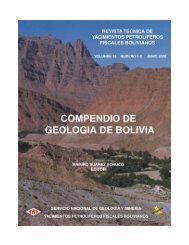Exploraciones por oro epitermal
Create successful ePaper yourself
Turn your PDF publications into a flip-book with our unique Google optimized e-Paper software.
Corbett: Epithermal Gold For Explorationists<br />
grades to 100 g/t occur in settings where fluids are inferred to have been quenched. Bicarbonate<br />
waters typical of carbonate-base metal gold deposits telescoped from higher levels mix with<br />
mineralised fluids to provide an improved mechanism of metal deposition and so also contribute<br />
towards higher gold grades (e.g., San Cristobal, Kidston). The recognition while prospecting quartzsulphide<br />
veins, of black/brown manganese wad derived from the weathering of the Mn Carbonate,<br />
rhodochrosite (below), commonly in vein flexures, is an indicator in many instances of higher gold<br />
grades. At Bilimoia (Irumifimpa) PNG bonanza gold grades are locally associated with<br />
tellurobismuthenite (Corbett et al., 1994; Hawkins and Akiro, 2001), and bismuth is anomalous in<br />
many quartz-sulphide systems (e.g., Mineral Hill). Most veins comprise coarse grained minerals<br />
(Photo 1) formed by slow cooling of the ore fluid at considerable depths and host gold on fractures or<br />
crystal boundaries to display good metallurgy (Corbett and Leach, 1998). However, in many<br />
systems where fluids have been quenched fine grained, particularly arsenic-bearing ores, gold may<br />
be encapsulated in the lattice and so these display difficult metallurgy (e.g., Lihir, Photo 4;<br />
Kerimenge, Photo 2).<br />
Metal zonation is most apparent as higher copper contents in many deeper systems (e.g., Mineral<br />
Hill, Photo 5), also recognised in veins similar to <strong>por</strong>phyry D veins, while those at higher crustal tend<br />
to be gold-rich (e.g., Lihir, Rawas). Lead and zinc occur in higher crustal levels as many quartzsulphide<br />
gold ± copper deposits pass vertically to higher level carbonate-base metal gold systems<br />
(e.g., Porgera, Kelian), which may also telescope downwards upon quartz-sulphide ores (e.g.,<br />
Tavatu, Fiji, Photo 6). Gold tends to be of a high fineness and silver contents increase in higher<br />
level epithermal deposit styles. Some transitional relationships are also recognised with adulariasericite<br />
(rift low sulphidation) gold deposits (e.g., Rawas, Gulbadi at Tolukuma), where the latter style<br />
may host higher gold grades and silver contents. Quartz-sulphide mineralisation dominates in many<br />
deeply eroded older magmatic arcs, typically forming ore systems where telescoping carbonate-base<br />
metal mineralisation provides potential for higher gold grades (e.g., Lake Cowal, London Victoria,<br />
Kidston).<br />
Quartz-sulphide gold + copper vein systems generally exploit pre-existing throughgoing regional<br />
structures (e.g., Adelong, Mineral Hill, Hamata, Arakompa, & Bilimoia), typically with higher metal<br />
grades and thicker intersections in local flexures (e.g., Jiang Cha Ling, Bilimoia) which form ore<br />
shoots. Others occur in the fractured carapace to larger intrusions (e.g., Nolan’s, La Arena Peru), or<br />
in association with subvolcanic breccias (e.g., Kidston, San Cristobal). At Emperor Gold Mine,<br />
auriferous quartz-sulphide comprises much of the ore in the laterally extensive flatmakes, developed<br />
by the reactivation of bedding planes during collapse aided by dilation (Corbett, in prep). The<br />
Andean pyrite-chalcopyrite-bearing tourmaline-quartz breccia pipes are transitional to this deposit<br />
style. In strongly dilational structural settings, quartz-sulphide ores, typically as characteristic<br />
sheeted veins, may be telescoped out from <strong>por</strong>phyry copper-gold systems as transitional to wall rock<br />
<strong>por</strong>phyries (e.g., Cadia, Photo 7).<br />
Photo 7. Sheeted vein system form Cadia Hill<br />
showing comb quartz veins with central pyrite<br />
and minor chalcopyrite.<br />
Photo 8. Parkers Hill polymetalic Ag<br />
mineralization at Mineral Hill comprising banded<br />
quartz and pyrite<br />
Paper 2002-01, April 2002 7
















